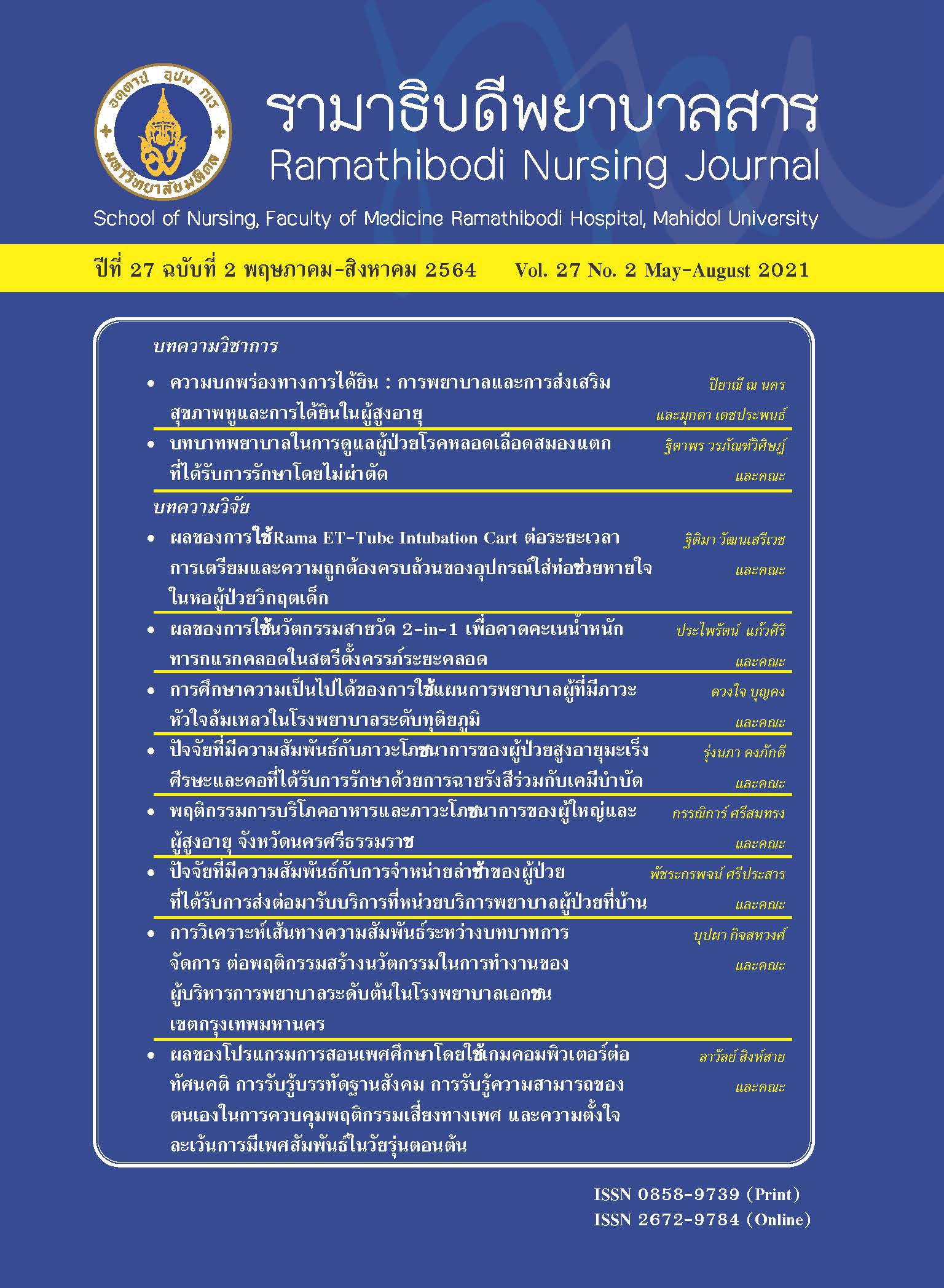Roles of Nurses in Caring for Patients with Non-Operative Hemorrhagic Stroke
Main Article Content
Abstract
Spontaneous intracerebral cerebral hemorrhage (SICH) is caused by a rupture of the blood vessel(s) in the brain. Major risk factors of cerebral hemorrhage include high blood pressure, smoking, and lack of exercise. The therapeutic regimens for SICH are either operation or non-operation, depending on pathology and criteria. This article aims to present evidence-based nursing about caring for patients with non-operation
hemorrhagic stroke, along with a case study. In clinical situations, nurses have major roles in providing standard care to control blood pressure and prevent intracranial pressure in these patients. The goal is to make them get through critical health issues safely. Based on the nursing process, nurses can apply the so-called ‘PAST-MANTT’ principle to provide essential care for these patients. This principle allows nurses to work systematically, from performing a problem analysis, patient assessment, specimen and test, treatment procedures, medication administration, activity, nutrition, teaching and education, and appropriate transfers. The provision of systematic care will lead to the best outcomes for these patients enabling them to recuperate at home and gain a quality of life.
Keywords: Nurse roles, Blood pressure, Increased intracranial pressure, Non-operative
hemorrhagic stroke
Article Details
บทความ ข้อมูล เนื้อหา รูปภาพ ฯลฯ ที่ได้รับการตีพิมพ์ในรามาธิบดีพยาบาลสาร ถือเป็นลิขสิทธิ์ของวารสาร หากบุคคลหรือหน่วยงานใดต้องการนำทั้งหมดหรือส่วนหนึ่งส่วนใดไปเผยแพร่หรือเพื่อกระทำการใด ใด จะต้องได้รับอนุญาตเป็นลายลักษณ์อักษรจากรามาธิบดีพยาบาลสารก่อนเท่านั้น
References
Strategy and Planning Division, Office of the Permanent Secretary. Public health statistics A.D. 2018 report:
Bangkok; 2018, p.101. (in Thai)
Medical Records, Suratthani Hospital. Intracecebral haemorrhage statistics 2019, Suratthani; 2019. (in Thai).
Areechokchai D, Vijitsoonthornkul K, Pongpan S,Maeakhian S. Population attributable fraction of stroke
risk factors in Thailand: utilization of non-communicable disease surveillance systems. OSIR. 2017;10 (1):1-6.
Macellari F, Paciaroni M, Agnelli G, Caso V. Neuroimaging in intracerebral hemorrhage. Stroke. 2014;45:903-8.
Guild SJ, Saxena UA, McBryde FD, Malpas SC,Ramchandra R. Intracranial pressure influences the level
of sympathetic tone. Am J Physiol Regul Integr Comp Physiol. 2018;315(5):R1049-53.
Sinsap N, Jankra J, Jaiman B. Hypertension in elderly:silence killer should be aware. Journal of Phrapokklao
Nursing College. 2017;28(1): 100-11. (in Thai)
Lloyd-Jones D, Adam R, Carnethon M, De Simone G,Ferguson TB, Flegal K, et al. Heart disease and stroke
statistics—2009 update: a report from the American Heart Association Statistics Committee and Stroke Statistics
Subcommittee. Circulation. 2009;119(3):480-6.
Song YM, Sung J, Lawlor DA, Davey Smith G, Shin Y,Ebrahim S. Blood pressure, heamorrhagic stroke, and
ischemic stroke: the Korean national prospective occupational cohort study. BMJ. 2004; 328(7435):324-5.
Leppälä JM, Virtamo J, Fogelholm R, Albanes D,Heinonen OP. Different risk factors for different stroke
subtypes: association of blood pressure, cholesterol, and antioxidants. Stroke. 1999;30(12):2535-40.
Muñoz RN, Méndez BM, Hernández BV, Jimenez GR,Jesus EH, et al. Type 2 diabetes and hemorrhagic stroke:
a population-based study in Spain from 2003 to 2012. J Stroke Cerebrovasc Dis. 2016; 25(6): 1431-43.
Suh I, Jee SH, Kim HC, Nam CM, Kim IS, Appel LJ. Low serum cholesterol and haemorrhagic stroke in men: Korea medical insurance corporation study. Lancet. 2001;357(9260):922-5.
Ikehara S, Iso H, Yamagishi K, Yamamoto S, Inoue M.Alcohol consumption, social support, and risk of stroke
and coronary heart disease among Japanese men. Alcohol Clin Exp Res. 2009;33(6):1025-32.
Aguilar MI, Brott TG. Update in intracerebral hemorrhage. Neurohospitalist. 2011;1:148–59.
Melo TP, Pinto AN, Ferro JM. Headache in intracerebral hematomas. Neurology. 1996;47(2):494-500.
Panjisee S, Pearnpathom N, Weerasarn K. Clinical practice guidelines for hemorrhagic stroke. Bangkok: Thana Press;2013. (in Thai)
Makris M, Van Veen JJ. Three or four factor prothrombin complex concentrate for emergency anticoagulation
reversal?. Blood Transfus. 2011;9(2):117-9.
Qureshi Al. Antihypertensive treatment of acute cerebral haemorrhage (ATACH): rationale and design. Neurocrit Care. 2007;6(1):56-66.
Ropper AH. Hyperosmolar therapy for raised intracranial pressure. N Eng J Med. 2012;367:746-52.
Raccah BH, Perlman A, Danenberg HD, et al. Major bleeding and hemorrhagic stroke with direct oral
anticoagulants in patients with renal failure: systematic review and meta-analysis of randomized trials. Chest.
;149(6):1516–24.
Claassen J, Jette N, Chum F, Green R, Schmidt M, Choi H, et al. Electrographic seizures and periodic discharges
after intracerebral haemorrhage. Neurology. 2007;69(13):1356-65.
Prakash A, Matta BF. Hyperglycemia and neurological injury. Curr Opin Anesthesiol. 2008; 21(5):565-9.
World Health Organization. World stroke campaign [Internet]. 2015 [cited 2017 Jan 21] Available from:
http://www.world-stroke.org/advocacy/world-strokecampaign
Stroke Association. Disclaimer and privacy policy to stroke rehab [Internet]. 2010-2017 [cited 2017 February 12].Available from: http://www. Stroke-rehab.com/disclaimer-and-privacy-policy.html


